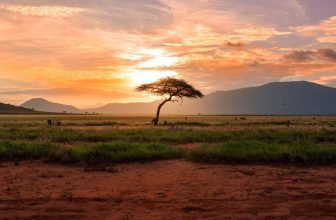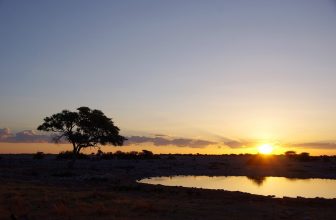Serengeti National Park is home to one of the world’s most famous natural wonders. Neatly tucked in the north-central region of Tanzania, the Serengeti plain is a protected area that contains approximately 11,500 square miles of land.
With more than 35 different wildlife species on the plain, the Serengeti is a haven for animal and nature enthusiasts.
The animals in Serengeti National Park put on full display the lure and charm of Tanzania. Whether it be mammals, birds, or reptiles, Serengeti National Park is laden with an exquisite array of wildlife.
If you’re considering a trip to Tanzania, or simply want to learn more about the country’s wildlife, here’s a list of the most fascinating animals in Serengeti National Park.
Tip: Explore tons of magnificent Tanzania safari vacations at Serengeti National Park’s home country.
Mammals in Serengeti National Park
Mammals are a class of warm-blooded animals. They often have bodies covered in hair and the female mammals have the ability to secrete milk for their young. Have a look at what makes these animals so unique.
Wildebeest

Wildebeest, otherwise known as gnu, are antelopes native to southern and eastern Africa. Their name comes from the Dutch word meaning “wild beast” due to its feral appearance and aggressive nature. The indigenous species in the Serengeti have gray, brown, or black fur depending on the season.
When not grazing, you’ll find wildebeest in a rut – a mating ritual connected to the full moon. During mating season, the territorial and dominant bulls demonstrate their dominance through aggressive mating sounds.
The bulls are incredibly macho and energetic during this season. They are more likely to fight, compete, and call to each other during rutting period.
Fun fact: Wildebeest take part in the world’s largest animal migration. Read more about this annual spectacle in this article on the Great Wildebeest Migration.
African Wild Dog

Not to be confused with the hyenas, African wild dogs are a fierce species of canine found across southern and eastern Africa. You might have also heard them referred to as “painted dogs”, “painted wolves”, or “the Cape hunting dog”.
They have a patchy black and brown coat, protruding ears, and a bushy tail. Their diet predominantly consists of a variety of antelopes, wildebeest calves, birds, and warthogs.
African wild dogs are a rare sighting in safari tours as they usually steer clear from lions and hyenas. They are nevertheless energetic creatures with a friendlier demeanor than most wild dogs.
Hartebees

Hartebees are a unique type of African antelope commonly found in Sub-Saharan and eastern Africa. These fawn-colored creatures with distinctly-shaped horns spend most of their time grazing in large herds.
Hartebees usually give birth to a single calf every year. Birth peak times are common in the dry season. Habit destruction, infrequent births, and widespread hunting has critically endangered these communal animals.
As a result, there are plenty of extinction prevention programs dedicated to salvage the declining Hartebees population.
Want to know more? Check out these interesting facts about Hartebees conservation.
Giraffe

Giraffes are the tallest mammals on Earth and are difficult to miss on a safari tour. Despite their extremely long length, giraffes surprisingly only have seven bones in their neck. These towering mammals are covered in brown patchy spots and each giraffe has a unique pattern.
A giraffe is a difficult hunt for common predators like lions and hyenas. Their towering height provides excellent eyesight and they can spot potential danger from a mile away.
Giraffes spend most of their time plucking leaves and twigs off of trees. When not appeasing their insatiable appetite, you’ll find giraffes chewing their curd or finding new territory to occupy.
Birds in Serengeti National Park
Birds are a common sighting in Serengeti National Park. Often decorating the Tanzanian sky (or land) with dynamic colors and high-spirited calls, birds are arguably the Serengeti’s most vibrant characters. Have a look at Serengeti National Park’s most interesting birds.
Gray Crowned Crane

Standing over two feet tall, the Gray crowned crane has gray and white feathers. Their most striking feature is their golden feathers atop their heads which form a lavish crown.
A capable communicator, the Gray crowned crane is known for its resonant honks. These feathered fellows enjoy dancing as a mating display. When dancing, they will shuffle their feet, bow, and jump. They also have a vibrant mating dance where the cranes move in synchronized passion.
Interestingly, the Gray crowned crane is the national bird of Uganda and appears on the nation’s flag.
Tip: If you’d like to check out the Gray crowned crane and other safari wildlife, check out these luxury safaris to Africa.
Ostrich

Native to Africa’s semi-arid plains and woodlands, ostriches are the world’s largest birds. These herbivorous birds cannot fly, but move swiftly on their feet. Ostriches can sprint to speeds of up to 43 miles per hour. Their long legs allow them to cover 10 miles in a single stride.
This flightless bird has a noteworthy lifespan; they live anything between 50 and 70 years. Because their diet consists of tough plants, ostriches have three stomachs to help with digestion.
African Fish Eagle

The African fish eagle has a very distinctive appearance. Similar to the American bald eagle, their bodies are typically 25-30 inches in length. They have large chestnut brown feathers which propel them to up to 20 miles per hour.
As kleptoparasites, African fish eagles typically steal their prey from other animals. Their diet mainly consists of fish. And their superb eyesight makes them agile hunters. They are also known to feast on dead carcasses.
These iconic birds are the national bird for three countries in Africa, namely Zimbabwe, Zambia, and South Sudan. Their resounding birdcall is commonly referred to as ‘the sound of Africa’.
Reptiles in Serengeti National Park
Reptiles are also a common sighting in Serengeti National Park. They are distinguished by their scaly appearance and their ability to lay eggs. These cold-blooded creatures play an important role in the ecosystem, including regulating the population of small animals. Have a look at what makes the Serengeti’s reptiles so iconic.
Kinyongia

The Kinyongia is a recently discovered species of chameleon. Native to northern Tanzania and southern Kenya, the chameleon was named after Charles A. Msuya, who dedicated his life to exploring indigenous Tanzanian reptilia. The blade-nosed lizard represents a remarkable breakthrough in African zoology.
There are many Kinyongia species, each with their own unique habitat and anatomical features. Their body color ranges from green, brown, or a faint yellow hue. Kinyongia chameleons have a staple diet consisting mostly of worms and crickets. They are known to especially enjoy silkworms.
Like most chameleons, the Kiyongia have a sensitive immune system and can easily die from parasitic infections. Their modest life spans compared to other chameleons are relatively average, ranging from three to five years.
Nile Crocodile

The Nile crocodile is Africa’s largest crocodile species. Quite the flexible creatures, Nile crocodiles live in both fresh and saltwater. These cold-blooded reptiles are commonly found in Sub-Saharan Africa, the Nile basin, and Madagascan rivers.
Nile crocodiles are extremely strategic, agile and opportunistic hunters. They are apex predators which means they sit atop the food chain. It should come as no surprise that these hard-scaled reptiles have the most powerful bite in the animal kingdom.
African Rock Python

The African rock python, like all pythons, is non-venomous. This slithering reptile is native to Sub-Saharan, eastern and central Africa. A common sighting in Serengeti National Park, African rock pythons spend most of their time eating, digesting, and laying eggs.
Female African rock pythons lay approximately 20-100 hard and oval-shaped eggs. Extremely protective of their hatchlings, the female aggressively guards her eggs through an incubation period that lasts two weeks.
Of all snakes, the African rock python is, interestingly, the most anatomically primitive. This means they require more internal organs to survive compared to other more advanced snakes.
Frequently Asked Questions about Animals in the Serengeti National Park?
Time to answer some of the burning questions you may have about the Big Five.
What Makes Animals in Serengeti National Park So Special?
Serengeti National Park has an expansive array of wildlife. The ecosystem is unique because it possesses a multitude of plants, animals, and organisms that function symbiotically within the same geographic location. The magnitude and variety of the ecology at Serengeti National Park is what makes the animals so unique.
Aren’t the Animals Better Off in the Wild?
Although Serengeti National Park is an enclosed area, it consists of 11,500 square miles of land. The animals have ample space to roam around. The protected area is for conservation purposes.
Is It Ethical To Profit From Animals Contained in a National Park?
At Serengeti National Park, the animals are given the best care. The buildings are unobtrusive to the ecology and the protection of nature is non-negotiable. The tourism industry and neighboring communities also benefit immensely from Serengeti National Park.
Are There Any Non-Land Animals at Serengeti National Park?
Interestingly, the Serengeti does not have many water animals. The catfish of the Mara and Grumeti rivers live in muddy, low oxygen water. But even they, too, survive through drought seasons without much water at all. The closest to water animals in Serengeti National Park are amphibians, such as frogs and salamanders.






